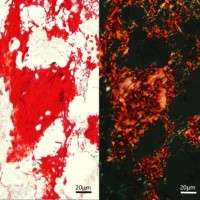Nano engineering advances bone-forming material

Murdoch University nanotechnology researchers have successfully engineered synthetic materials which encouraged bone formation in sheep.
The advancement means the successful use of synthetic materials in bone grafts for human patients is a step closer. The material could also have potential future applications in fracture repair and reconstructive surgery.
Currently the patient's own bone, donated bone or artificial materials are used for bone grafts but limitations with all these options have prompted researchers to investigate how synthetic materials can be enhanced.
Dr Eddy Poinern and his team from the Murdoch Applied Nanotechnology Research Group worked with powdered forms of the bio ceramic hydroxyapatite (HAP) to form pellets with a sponge-like structure which were then successfully implanted behind the shoulders of four sheep by collaborators from the School of Veterinary and Life Sciences at Murdoch University.
HAP is already being used in a number of biomedical applications such as bone augmentation in dentistry because of its similarity to the inorganic mineral component of human bone. But treatments of HAP so that it can be successfully used in a bone graft have yet to be developed because of the complexities involved with compatibility and HAP's load bearing limitations.
Dr Poinern and his team prepared pellets with varying density and porosity using a variety of chemical methods including sintering, ultrasound and microwaves. Four pellets were implanted into muscles in each of the sheep, later demonstrating good bio-compatibility, including mixed cell colonisation after four weeks and even new bone formation 12 weeks after the surgery.
"Using synthetic materials in this way is difficult and complicated because they need to be engineered to be porous and to replicate the various physical, chemical and mechanical properties found in natural bone tissue," explained Dr Poinern.
"They also need to be non-toxic and have a degradation rate which will allow for cells from the host to steadily recolonize the area and permit the formation of blood vessels necessary for the delivery of nutrients to the forming bone tissues.
"We already knew that synthetic HAP was a good material to study for possible use in bone-related medicine, but we needed to find out if the pellets we'd engineered were bio-compatible.
"Our results were very positive – our pellets acted as a scaffold for the growth of bone material, made possible because of its porous properties allowing cells to infiltrate.
"The pellets were also very cost effective to make."
Although the study was small scale and originally intended to test the bio-compatibility of the HAP pellets, the bone growth was beyond what the interdisciplinary team expected.
Associate Professor Martin Cake, who surgically implanted the pellets into the sheep, described the results as "stunning" and said they boded well for the use of engineered HAP in bone implants.
"This material begins as a powder that can be theoretically moulded to any shape, or perhaps one day even 3D printed, then sintered to harden it," he said.
Associate Professor Phil Nicholls, who undertook the pathology in the study added: "It's early days but we are hoping this work will help develop further collaborations both between our own schools, and with other institutions.
"It is an example of why we think the emerging health campus surrounding the new Fiona Stanley Hospital will be a real catalyst for translational research. There are few other places where this combination of capabilities is located on the one precinct."
Dr Poinern said he was hoping to improve and match the physical and mechanical properties of the pellets with those of natural bone tissue in a new study.
"Once these properties have been achieved, further implantation studies will be carried out to establish the feasibility of using this scaffold for bone grafts," he said.
Dr Poinern et al's paper on the research was published in Nature's Scientific Reports journal.
The implantation study was carried out in non pregnant Merino ewes with the approval of Murdoch University's Animal Ethics Committee and all experiments were conducted in accordance with the Australian National Health and Medical Research Council's (NHMRC) Code of Practice for the care and use of animals for scientific purposes.
In accordance with the ethical principles of the Code, the sheep were simultaneously used in an unrelated trial involving surgery of the stifle joints.
After the pellets were removed, the sheep were humanely euthanased.
More information: "The synthesis, characterisation and in vivo study of a bioceramic for potential tissue regeneration applications" Gérrard Eddy Jai Poinern, Ravi Krishna Brundavanam, Xuan Thi Le, Philip K. Nicholls, Martin A. Cake, Derek Fawcett Scientific Reports 4, Article number: 6235 DOI: 10.1038/srep06235
Journal information: Scientific Reports
Provided by Murdoch University

















